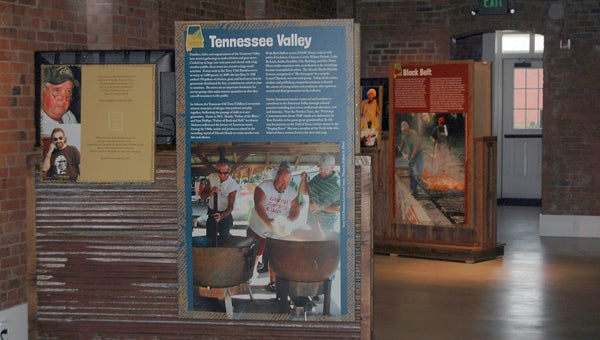Alabama in the Making: Traditional Arts of People and Place
Published 10:30 pm Friday, August 3, 2012

The Alabama in the Making traveling exhibition opens today at the Johnson Center for the Arts. The exhibition features interactive kiosks from five regions of the state: the Gulf Coast, Black Belt, the Southern Appalachians, Wire Grass, and the Tennessee Valley. (Photo/Jaine Treadwell)
Folklife traditions and landscapes will be the feature of the “Alabama in the Making: Traditional Arts of People and Place” that opens today at the Johnson Center for the Arts.
This exhibit features the people of Alabama, whose faces, voices, stories and music will present the folklife traditions of their families and communities.
Visitors are invited to journey across the state and listen to Alabamians tell the story of cultural roots and meaningful places as translated through arts and traditions.
“As the keepers of knowledge, skills, values, beliefs and aspirations, Alabamians share their traditions through this traveling exhibit,” said Morgan Drinkard, Johnson Center executive director.
Through this traveling exhibit, people will have the opportunity to discover the many talents, skills and knowledge of Alabamians and also the contributions they continue to make to American culture.
“The opportunity to share this exhibit at the Johnson Center allows us to bring the culture of different regions to our community,” Drinkard said. “We hope everyone will take the time to visit this exhibit to learn more about the culture and folklife traditions of our state.”
By using iPads, visitors are able to navigate through the exhibition and listen to Alabamians tell the stories of their experiences in folk and traditional arts including foodways, music, occupational folklore and material culture.
Drinkard said faces familiar to the people of Pike County will include the late Agnes Johnson who tells a story of growing up in the rural South; Stanley Smith, a leader in the Sacred Harp community; and the late Kathryn Windham, legendary Alabama storyteller.
“Many of the people, places and traditions and much of the music will be familiar to most all of us,” Drinkard said. “The content will also be interesting to students, scholars, community educators and cultural organizations.”
There are five kiosks and each one represents a region of Alabama – the Gulf Coast, Southern Appalachians, Wiregrass, Black Belt and Tennessee Valley.
Some of the topics explored are gumbo, chicken and goat stew, blues, Native American traditions, Muscle Shoals music, Mardi Gras, fishing techniques, Sacred Harp singing, fiddle making, basket making, quilting and storytelling.
Drinkard said benches invite visitors to sit and enjoy each kiosk at their own time and at their own pace.
“There are visual and audio selections at each kiosk,” Drinkard said. “Visitors can easily access the selections. Some of them are less than a minute and others are up to five minutes. This is the kind of exhibit that you’ll probably want to come back and enjoy more than once and we certainly invite everyone to do so.”
“Alabama in the Making” will be featured in the lower level gallery of the Johnson Center through Sept. 6.
During the same time frame, the Johnson Center for the Arts is also presenting, “Faith, Magic, Love & Death, Cautionary Tales of the End Times” in the Upper Level Galleries.
“This exhibition is extraordinary. It features the narrative visions of Marc Berghaus, Marko Fields, Oscar Gillespie, Stephanie Hunder, Richard Notkin and Barbara Waterman Peters,” Drinkard said. “This traveling exhibit schedule includes visits to Minneapolis, Minnesota; Manhattan, Kansas; Troy, Alabama; and Denver, Colorado. So, we are in company with some really big cities and that says a lot about the Johnson Center for the Arts, Troy and Alabama.”
The “Alabama in the Making” exhibit is made possible by the Alabama Folklife Association through funding from the National Endowment for the Arts, the National Endowment for the Humanities, the Alabama State Council on the Arts and the Alabama Humanities Foundation.
The Johnson Center for the Arts is located at 300 East Walnut Street in downtown Troy. Exhibit hours are 10 a.m. until 5 p.m. Wednesday through Friday and from 10 a.m. until 3 p.m. on Saturday.
Admission to the Johnson Center is free of charge.



